Content
Enigma
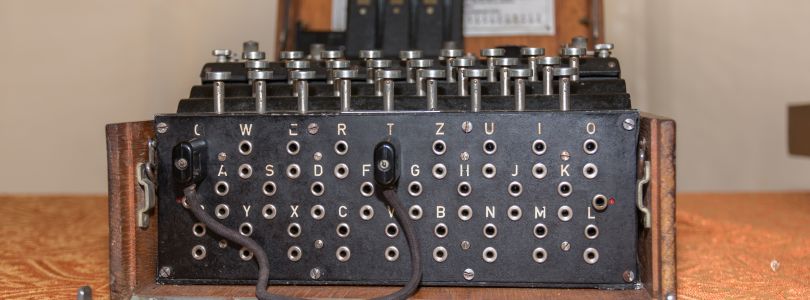
Enigma - cryptography and war
Enigma: This is the exciting story of an ingenious machine for encrypting messages and the brilliant minds who cracked it - and thus crucially influenced the course of the Second World War.
During WWI, on 23 February 1918, Arthur Scherbius (1878-1929) filed a patent application for his first “cipher apparatus” ( ![]() DE416219). Iit already contained the essential elements of the Enigma, which was to become the most important cryptographer used in German military communication.
DE416219). Iit already contained the essential elements of the Enigma, which was to become the most important cryptographer used in German military communication.
Before Scherbius, the American Edward H. Hebern had already applied for a patent for a cipher machine with rotating discs (e.g. ![]() US1510441A (1,74 MB),
US1510441A (1,74 MB), ![]() US1084010 od
US1084010 od ![]() US1086823); at the same time, other engineers had similar ideas (see
US1086823); at the same time, other engineers had similar ideas (see ![]() DE411126A und
DE411126A und ![]() DE385682A ).
DE385682A ).
Scherbius was an accomplished engineer who had excelled in particular in the development of circuits. After he had tried in vain to offer his invention to the military still during the First World War, the Enigma manufacturers relied on customers from the international business community who wanted to keep their communications secret. Scherbius had continued to further develop the Enigma until he died in an accident in 1929 (see e.g. ![]() DE425147A,
DE425147A, ![]() DE378238,
DE378238, ![]() DE536556A).
DE536556A).
During the 1930s and Hitler’s preparations for war, the military became far more interested in the Enigma. It was taken out of the public domain and used for secret communications between the German army, air force and navy.
158.962.555.217.826.360.000
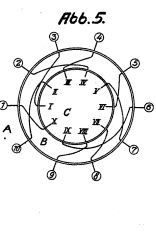
Drawing from DE425147
The Enigma (derived from the Greek word for “riddle/mystery”) encrypted texts with a system of three or more rotating interchangeable discs (rotors) and plugboard connections, which theoretically offered 158,962,555,217,826,360,000 different keys. The texts were typed in like on a typewriter and the output, a jumble of letters, was then sent by Morse code.
The sender and the recipient each needed an Enigma machine with exactly the same configuration, which was changed regularly during the war (daily at midnight in the German navy). Both sides also needed the code books, in which the changing settings (day keys) were specified.
The Enigma had a serious cryptographic weakness: The “reflector” made it impossible for any entered letter to ever be mapped to itself. That means, for example, that an “A” never appeared as an “A” in the encrypted text but was always replaced by another letter. This significantly reduced the possible Alphabet variants and became an important gateway for code breakers.
Weather forecast as Achilles heel
Furthermore - apart from some sloppiness and individual mistakes - German thoroughness of all things helped to crack the Enigma: Every morning at the same time a weather forecast was transmitted. This naturally contained many recurring terms, which provided the code breakers with starting points for cracking the code.
However, the crucial preparatory work for the disenchantment of the Enigma machine had already been done in Poland in the 1930s: The great mathematician Marian Rejewski (1905-1980) had researched essential principles of the machine and passed his knowledge on to British scientists shortly before the outbreak of war. Rejewski also developed the first cryptanalytic machine for deciphering code named “bomba”. Shortly before the war broke out, Rejewski and his colleagues were able to pass on their knowledge to British intelligence officials at a secret meeting in Pyry's Kabaty Forest.
Rejewski’s work – just like that of the British code crackers - only became known and appreciated decades after the end of the war.
Computer pioneer Alan Turing and his “bomb”
Rejewski’s work – just like that of the British code crackers - only became known and appreciated decades after the end of the war. Whereas Rejewski has not (yet) become a protagonist of films, Alan Turing (1912-1954) has received this late honour several times already („Enigma“, „The Imitation Game“). Together with Gordon Welchmann, Turing was the leading figure of British code breakers in ![]() Bletchely Park near London, who worked there under the project name “Ultra”, for example in the famous “Hut 6”. They used the intrinsic flaws of the Enigma, Rejewski’s significant preparatory work and captured code books to find ways to decipher the Enigma radio messages.
Bletchely Park near London, who worked there under the project name “Ultra”, for example in the famous “Hut 6”. They used the intrinsic flaws of the Enigma, Rejewski’s significant preparatory work and captured code books to find ways to decipher the Enigma radio messages.
By constructing the "bomb" named after him, the basic idea of which Turing had adopted from Rejewski and which he had developed further substantially, he became a father of modern computer technology. The giant apparatus was able to calculate the day key from approximately 1,054,560 possible values using “cribs” (words probably used in the radio message). By using hundreds of these “bombes” in England and the USA, it was finally possible to decode the German radio messages within a few minutes.
Consequently, the Allied forces were informed of all the steps of the Germans, which gave them a substantial advantage and enabled them to act accordingly. The importance of this knowledge lead can hardly be overestimated. The outcome of the submarine war in the Atlantic was decisively influenced by the decoding of German communications.
U-559 is lost – and with it the entire submarine war
The code breakers in Bletchley Park initially had much greater problems with the more complicated encryption system of the German navy than with that of the other German armed forces, which had been cracked soon after the war began. It took until May 1941, before “Ultra” was able to decode the navy communications. Between February and December 1942, there was what was called a black-out, when the German navy introduced the new four-rotor Enigma M-4 and the “Triton” code system. Only after the German submarine U-559 was captured, including the Enigma and code books, Turing and his staff succeeded again in deciphering the radio messages. This was the decisive point in the submarine war.
Secret until the 1970s
Almost as important as the decryption of the Enigma was the fact that the British were able to keep their knowledge secret. The German side did not suspect until the end of the war (and long after that!) that the enemy was able to read all radio messages. The confidence of the Nazi armed forces in the “uncrackability” of the Enigma remained undiminished.
The British, for their part, communicated with a similar cipher machine called Typex, whose developers avoided the flaws of the Enigma (e.g. by using multiple turnover notches). Hitler’s cryptographers never managed to break those codes.
Today, the most important scientific award for computer science is named after Alan Turing, to whom his country did not thank his merits only until decades after his tragic death. The "Turing Test" still is an indicator for artificial intelligence and in Great Britain, his face will adorn the 50-pound banknote from 2021.
Encryption methods are still in demand today, as shown by recent patent applications such as ![]() DE102016112552A1 or
DE102016112552A1 or ![]() EP3346632A1.
EP3346632A1.
Without the Enigma decryption World War II might not have ended 75 years ago
Bletchley Park's mathematicians and cryptanalysts made a decisive contribution to shortening the Second World War - and thus saving lives - by decoding the Enigma. In the last two years of the war, significantly more people died on the German side in particular than in the five years before. Each additional day of hopeless fighting claimed increasing numbers of victims among soldiers and civilians. Moreover, if the war had lasted longer in Europe, the atomic bomb would probably have been used against Germany first. It is therefore reasonable to assume that the decoding of the Enigma indirectly saved millions of lives.
Pictures: iStock.com/giorez, DEPATISnet, J.B. Spector / Museum of Science and Industry Chicago, Public domain via Wikimedia Commons
Last updated: 16 April 2025

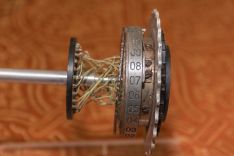

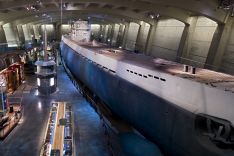
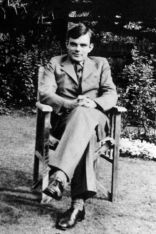
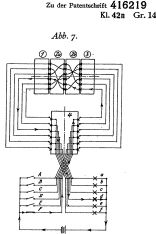
Not only protecting innovations
Social Media